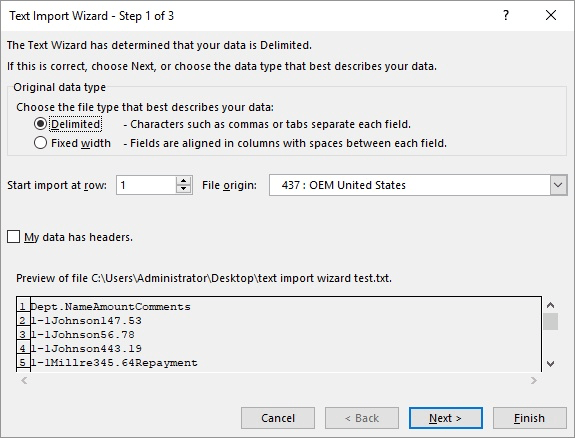Please Note: This article is written for users of the following Microsoft Excel versions: 2007, 2010, 2013, 2016, 2019, 2021, and Excel in Microsoft 365. If you are using an earlier version (Excel 2003 or earlier), this tip may not work for you. For a version of this tip written specifically for earlier versions of Excel, click here: Stopping Date Parsing when Opening a CSV File.
Written by Allen Wyatt (last updated June 1, 2024)
This tip applies to Excel 2007, 2010, 2013, 2016, 2019, 2021, and Excel in Microsoft 365
Marc has a user at his company who is trying to open a .CSV file in Excel. Some of the numbers in the file are in the format of "2-1" (or something similar). During the import, Excel parses this information as a date. If the piece of data is clearly something outside a valid date range (such as 2-134), then Excel imports it as would be expected. Marc is wondering how his user can force Excel to not parse this data as dates but to import them as text fields.
There are two easy ways you can approach this issue. First is to import the file in the following manner:

Figure 1. The Text Import Wizard.
The other way to approach the issue also involves the Text Import Wizard, but how you display it is different. In this approach, you use Windows to rename the file so that it has a .TXT extension instead of a .CSV extension. Now, when you use Excel to open the file, it displays the Text Import Wizard because it isn't quite sure how to interpret what it is going to be loading. You can use the Text Import Wizard in the same manner as already described earlier in this tip.
It should be noted that if you do this type of importing routinely (perhaps you need to import a particular file daily or weekly), then you may want to investigate using Power Query to do the importing. This tool is very powerful and you can use it to almost completely automate a specific import process.
ExcelTips is your source for cost-effective Microsoft Excel training. This tip (9179) applies to Microsoft Excel 2007, 2010, 2013, 2016, 2019, 2021, and Excel in Microsoft 365. You can find a version of this tip for the older menu interface of Excel here: Stopping Date Parsing when Opening a CSV File.

Create Custom Apps with VBA! Discover how to extend the capabilities of Office 365 applications with VBA programming. Written in clear terms and understandable language, the book includes systematic tutorials and contains both intermediate and advanced content for experienced VB developers. Designed to be comprehensive, the book addresses not just one Office application, but the entire Office suite. Check out Mastering VBA for Microsoft Office 365 today!
Open a workbook that someone else is working on, and you won't be able to save your changes back into the same file. ...
Discover MoreWhen you choose to save worksheet data in CSV format, Excel gives you three choices for file formats. Those choices are ...
Discover MoreWhen dealing with files containing comma-separated values, you want to make sure that what gets imported into Excel ...
Discover MoreFREE SERVICE: Get tips like this every week in ExcelTips, a free productivity newsletter. Enter your address and click "Subscribe."
There are currently no comments for this tip. (Be the first to leave your comment—just use the simple form above!)
Got a version of Excel that uses the ribbon interface (Excel 2007 or later)? This site is for you! If you use an earlier version of Excel, visit our ExcelTips site focusing on the menu interface.
FREE SERVICE: Get tips like this every week in ExcelTips, a free productivity newsletter. Enter your address and click "Subscribe."
Copyright © 2025 Sharon Parq Associates, Inc.
Comments